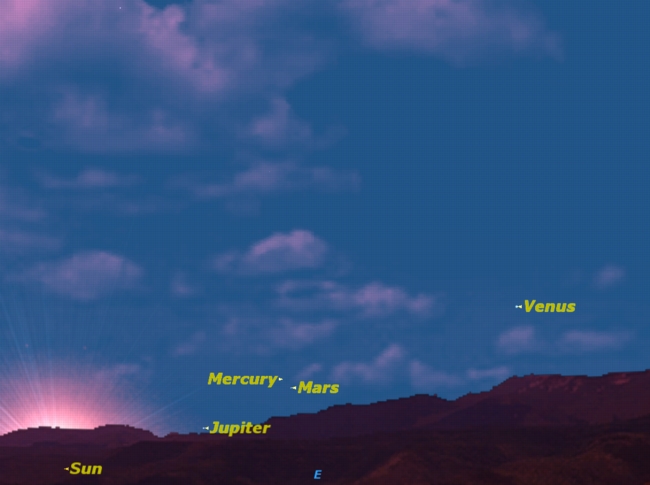Rare Sight: Mercury to Meet Mars at Dawn on Tuesday

Skywatchers set your alarm clocks: On Tuesday morning (April 19), Mercury will appear to have a close encounter with Mars.
In reality, the two planets will actually be separated by about 161 million miles (259 million kilometers), but in Earth’s sky they will appear only 2 degrees (which is about four moon widths) apart. You'll need to be up just before the sun, around 6:30 a.m. local time, to see this rare sight.
Mercury and Mars will appear very low in the eastern sky and will be difficult to see in morning twilight. You will need a very low eastern horizon, with few obstacles in the way.
Small binoculars will be a big help in spotting the two tiny specks of light, but first make sure the sun is safely behind a hilltop or other obstruction, as in this sky map of Mars and Mercury.
You can also use the much brighter planets Venus and Jupiter to locate Mercury and Mars.
To ancient astrologers, such conjunctions were fraught with ominous significance. To modern astronomers, they are merely a pretty sight, a photo opportunity. [Latest Mercury photos from NASA probe]
This is the first of a whole series of close encounters between six planets in the morning sky over the next two months. Saturn won’t participate in the dawn dance, since it is currently dominating the evening sky.
Get the Space.com Newsletter
Breaking space news, the latest updates on rocket launches, skywatching events and more!
Here is a run-down of these upcoming conjunctions:
April 19: Mercury and Mars
April 22: Venus and Uranus
May 1: Mars and Jupiter
May 8: Mercury and Venus
May 10: Mercury and Jupiter
May 11: Venus and Jupiter
May 18: Mercury and Venus (again)
May 20: Mercury and Mars (again)
May 22: Venus and Mars
Because of its rapid motion relative to the sun, Mercury manages two conjunctions each with both Venus and Mars. In addition, the waning crescent moon will pass through the gathering of planets in late April and again in late May.
Neptune is the only dawn planet not to be involved in a conjunction, because it is too far to the west.
These planet conjunctions offer many opportunities for beautiful photographs with ordinary cameras.
Use your lens at its longest telephoto setting, underexpose slightly to bring out the colors of the dawn sky, and try to frame the planets with the silhouettes of foreground objects.
This article was provided to SPACE.com by Starry Night Education, the leader in space science curriculum solutions.
Join our Space Forums to keep talking space on the latest missions, night sky and more! And if you have a news tip, correction or comment, let us know at: community@space.com.

Geoff Gaherty was Space.com's Night Sky columnist and in partnership with Starry Night software and a dedicated amateur astronomer who sought to share the wonders of the night sky with the world. Based in Canada, Geoff studied mathematics and physics at McGill University and earned a Ph.D. in anthropology from the University of Toronto, all while pursuing a passion for the night sky and serving as an astronomy communicator. He credited a partial solar eclipse observed in 1946 (at age 5) and his 1957 sighting of the Comet Arend-Roland as a teenager for sparking his interest in amateur astronomy. In 2008, Geoff won the Chant Medal from the Royal Astronomical Society of Canada, an award given to a Canadian amateur astronomer in recognition of their lifetime achievements. Sadly, Geoff passed away July 7, 2016 due to complications from a kidney transplant, but his legacy continues at Starry Night.

